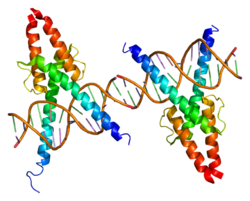MyoD, also known as myoblast determination protein 1,[5] is a protein in animals that plays a major role in regulating muscle differentiation. MyoD, which was discovered in the laboratory of Harold M. Weintraub,[6] belongs to a family of proteins known as myogenic regulatory factors (MRFs).[7] These bHLH (basic helix loop helix) transcription factors act sequentially in myogenic differentiation. Vertebrate MRF family members include MyoD1, Myf5, myogenin, and MRF4 (Myf6). In non-vertebrate animals, a single MyoD protein is typically found.
MyoD is one of the earliest markers of myogenic commitment. MyoD is expressed at extremely low and essentially undetectable levels in quiescent satellite cells, but expression of MyoD is activated in response to exercise or muscle tissue damage. The effect of MyoD on satellite cells is dose-dependent; high MyoD expression represses cell renewal, promotes terminal differentiation and can induce apoptosis. Although MyoD marks myoblast commitment, muscle development is not dramatically ablated in mouse mutants lacking the MyoD gene. This is likely due to functional redundancy from Myf5 and/or Mrf4. Nevertheless, the combination of MyoD and Myf5 is vital to the success of myogenesis.[8][9]
- ^ a b c GRCh38: Ensembl release 89: ENSG00000129152 – Ensembl, May 2017
- ^ a b c GRCm38: Ensembl release 89: ENSMUSG00000009471 – Ensembl, May 2017
- ^ "Human PubMed Reference:". National Center for Biotechnology Information, U.S. National Library of Medicine.
- ^ "Mouse PubMed Reference:". National Center for Biotechnology Information, U.S. National Library of Medicine.
- ^ "P15172 (MYOD1_HUMAN)". UniProtKB. Retrieved 17 July 2019.
- ^ Davis RL, Weintraub H, Lassar AB (Dec 1987). "Expression of a single transfected cDNA converts fibroblasts to myoblasts". Cell. 51 (6): 987–1000. doi:10.1016/0092-8674(87)90585-X. PMID 3690668. S2CID 37741454.
- ^ "Entrez Gene: MYOD1 myogenic differentiation 1".
- ^ Rudnicki MA, Schnegelsberg PN, Stead RH, Braun T, Arnold HH, Jaenisch R (Dec 1993). "MyoD or Myf-5 is required for the formation of skeletal muscle". Cell. 75 (7): 1351–1359. doi:10.1016/0092-8674(93)90621-V. PMID 8269513. S2CID 27322641.
- ^ Hinits Y, Williams VC, Sweetman D, Donn TM, Ma TP, Moens CB, Hughes SM (Oct 2011). "Defective cranial skeletal development, larval lethality and haploinsufficiency in Myod mutant zebrafish". Dev. Biol. 358 (1): 102–112. doi:10.1016/j.ydbio.2011.07.015. PMC 3360969. PMID 21798255.
© MMXXIII Rich X Search. We shall prevail. All rights reserved. Rich X Search






